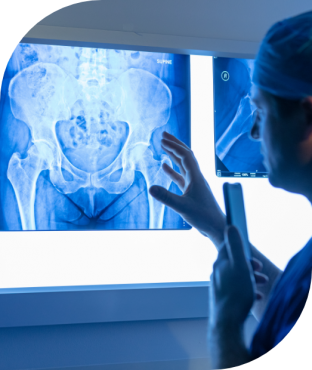Fracture Management
What is a Fracture?
Fracture is the medical term for a broken bone. Fractures may be displaced or undisplaced (like a crack). Most fractures occur as a result of trauma from trips or falls, sporting injuries, a direct impact injury or perhaps a severe motor vehicle accident. Pathological fractures are much less common and tend to occur in the absence of trauma, where the bone has been weakened by a medical condition causing the bone to break under normal loads. Conditions that may cause pathologic failure could include bone tumours, osteoporosis, or metabolic bone diseases. Stress fractures occur when a bone is subjected to repetitive loads that overwhelm the bone’s natural healing and remodelling processes, ultimately leading to a fracture.
Fractures can be classified as:

- Simple- undisplaced and well aligned.
- Unstable- displaced or angulated.
- Comminuted- inlvolving multiple fragments.
- Open or Compound- the fracture is associated with a break in the skin or communicates with a wound. These fractures can be complicated by infection of the bone and require urgent surgical treatment.
- Greenstick- The bone is bent rather than completely fractured. This is common in children.
Fractures are generally diagnosed with simple xrays or radiographs. In some cases, computed tomography (CT), Magnetic Resonance Imaging (MRI) or a Bone Scan may be required to make the diagnosis or add further information.

Surgical and non-operative treatments available
Fractures can be managed both surgically and non-operatively. This treatment decision is based on an assessment of displacement, alignment and stability of the fracture. When
fractures involve a joint surface, it is critical that this surface remains congruent to prevent post traumatic arthritis. Other factors include the age of the patient, the bone involved and
the likely impact on function of surrounding joints.
Non-operative management involves application of casts or splints to immobilise the fracture until it heals sufficiently. This is generally done by a physiotherapist or hand therapist.
Common surgical options include a closed reduction, external fixation and open reduction with internal fixation. Some fractures require manipulation under anaesthesia followed by cast application. This is common in paediatric fractures. More commonly, displaced fractures are managed with open reduction where an incision is made over the fracture to allow the bone to be reduced back to it’s anatomical position. Hardware such plates and screws, rods or wires are then used to maintain the fracture position with internal fixation until bone healing occurs. External fixation using large frames and external pins are generally reserved for high-end trauma situations with significant soft tissue damage.

